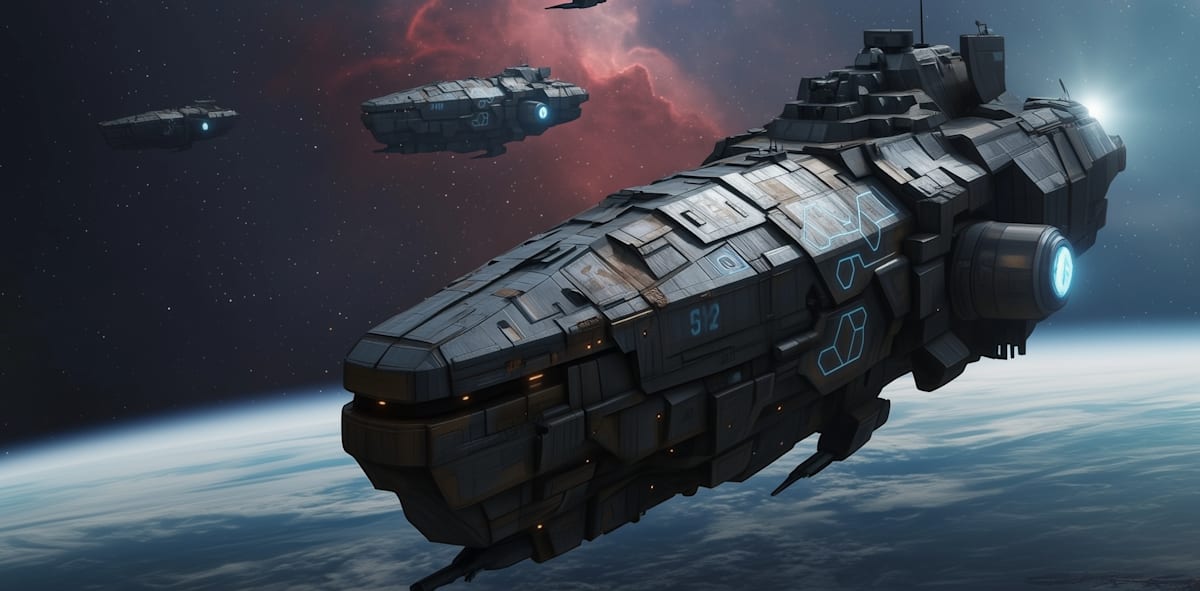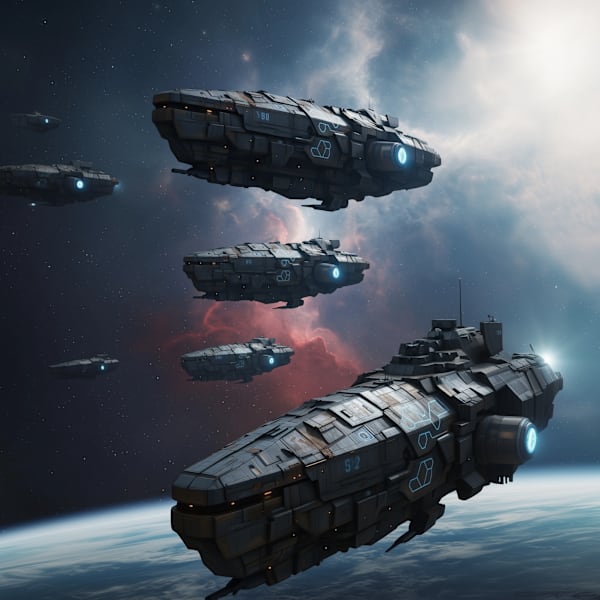A tactical analysis of the four technologies that ended the Age of Railgun Supremacy
In 2160, when Lieutenant Maria Roszak's survey team discovered an ancient alien wreck in the Theta² Tauri debris field, they unknowingly triggered the most radical transformation in space warfare since humans first mounted weapons on starships. Within five years, the technologies reverse-engineered from that derelict vessel would shatter every tactical doctrine, render entire fleets obsolete, and fundamentally rewrite the rules of interstellar combat.
Before we examine this revolution, we must understand the brutal reality of pre-2160 space warfare: the Age of Railgun Supremacy.
The Old Paradigm: When Offense Ruled Absolutely
Space combat before the alien discovery was a terrifying game of mutual destruction. Railgun projectiles traveling at 0.1c—30,000 kilometers per second—could cross typical engagement ranges in mere seconds, giving defending ships virtually no time to react. With projectiles moving this fast, interception was theoretically possible but practically suicidal to attempt.
The mathematics were unforgiving. A railgun round fired at 300,000 kilometers would impact in just 10 seconds. Within that window, a ship had to detect the launch, calculate trajectory, aim defensive systems, fire countermeasures, and destroy the incoming projectile. Only the Anglo-Saxon Coalition's advanced AI systems could even attempt this feat, and their success rate remained classified—though rumored to be devastatingly low.
The result? Space battles resembled ancient naval combat more than the dynamic dogfights science fiction promised. Fleets formed rigid lines of battle, relying on concentrated firepower and heavy armor. Ships died quickly when caught out of position. Smaller vessels served primarily as scouts and missile platforms, unable to survive direct engagement with capital ships. Most critically, point defense was considered a luxury only the wealthiest fleets could afford—and even then, it rarely worked.
Polonia Prime's discovery changed everything.
Revolution 1: Bubble Drive Micro-Jumps - The Death of Linear Tactics
The first shock came when Polonia Prime ships began demonstrating tactical micro-jumps during joint exercises. Instead of the ponderous maneuvering that characterized conventional space combat, destroyers like the PNS Błyskawica could simply disappear from one position and materialize elsewhere on the battlefield instantaneously.
The implications were staggering:
Traditional formations became death traps. Ships arranged in neat lines of battle found themselves flanked by enemies who had jumped behind their formations. The careful positioning that took hours to achieve could be countered in seconds.
Railgun targeting became nearly impossible. How do you hit a target that can jump away the moment your weapon fires? Even with AI-assisted prediction, ships with bubble drives could execute multiple micro-jumps in rapid succession, appearing in locations no algorithm could predict.
Smaller ships gained unprecedented power. A destroyer with bubble drive technology could engage a dreadnought, jump away before retaliation arrived, and repeat the process indefinitely. Size and armor became less important than mobility and energy reserves.
Strategic deployment transformed overnight. Fleets could now appear anywhere in a system within minutes rather than weeks. The concept of secure rear areas vanished. Every world, every station, every supply depot became a potential front line.
Most revolutionary of all was the emergence of "swarm tactics"—multiple small vessels executing coordinated micro-jumps to attack from all vectors simultaneously. Traditional point defense systems, already struggling with railgun interception, proved completely helpless against enemies that could teleport behind their coverage zones.
Revolution 2: Structural Integrity Fields - Warships Without Weakness
The second transformation was subtler but equally profound. Polonia Prime's structural integrity fields didn't just make their ships stronger—they eliminated the most fundamental vulnerability in space warfare: catastrophic decompression.
Before integrity fields, every hull breach was potentially fatal. Ships required multiple sealed compartments, emergency bulkheads, and crews trained to fight in full environmental suits. Combat damage assessment focused as much on life support as weapons systems. A single lucky hit could kill hundreds through explosive decompression.
Polonia Prime warships changed this calculus completely:
Crews fought in shirtsleeves. While enemy personnel struggled with the bulk and limitations of spacesuits during combat operations, Polish crews operated at peak efficiency. Their reaction times, manual dexterity, and endurance far exceeded suited opponents.
Simplified ship architecture. Without the need for complex compartmentalization and emergency sealing systems, Polonia Prime vessels could dedicate more space and mass to weapons, drives, and power systems. Their ships became more efficient and capable per ton than any competitor.
Reduced crew training requirements. Personnel no longer needed extensive suit training and emergency decompression drills. This allowed for more specialized combat training and faster crew replacement.
Psychological advantages. Fighting in a comfortable environment while knowing the enemy struggled with environmental suits provided significant morale benefits. Polonia Prime crews reported feeling "invulnerable" compared to conventionally equipped vessels.
Most importantly, integrity fields allowed ships to continue fighting through damage that would cripple conventional vessels. A Polonia Prime destroyer with multiple hull breaches remained fully operational while enemy ships of similar size would be fighting for survival.
Revolution 3: Star Cores - Unlimited Power, Unlimited Possibilities
Perhaps no technology gap was more decisive than Polonia Prime's energy advantage. The alien "Star Cores" generated power equivalent to one hundred standard fusion reactors in a fraction of the space, giving Polish ships energy resources that seemed almost magical to their opponents.
This power revolution enabled multiple tactical advantages:
High-energy laser systems. While other navies struggled to power effective laser weapons, Polonia Prime ships mounted laser arrays that could engage multiple targets simultaneously. These weren't the limited-range point defense lasers other factions used—these were ship-killing weapons with extreme range and accuracy.
Enhanced bubble drives. The energy requirements for rapid micro-jumps were enormous. Star Cores allowed Polonia Prime vessels to execute multiple consecutive jumps without the long recharge periods that limited other ships equipped with stolen or inferior drive technology.
Powered armor and enhanced life support. The abundant energy allowed for crew protection systems and comfort levels impossible on energy-constrained vessels. Polish crews fought at peak effectiveness while opponents struggled with power rationing.
Electronic warfare capabilities. Star Cores powered sophisticated jamming and sensor systems that could disrupt enemy coordination while maintaining perfect situational awareness.
The psychological impact was perhaps equally important. Enemy commanders knew that Polonia Prime ships could fight at full capacity indefinitely while their own vessels faced careful energy management even during peak combat.
Revolution 4: Quantum AI Point Defense - The Return of Small Craft
The fourth revolution addressed the fundamental problem that had made space combat so deadly: railgun interception. Polonia Prime's quantum AI systems, integrating alien computational matrices with human technology, achieved the impossible—reliable point defense against 0.1c projectiles.
This changed everything:
The invincible railgun met its match. For the first time since humans began mounting kinetic weapons in space, ships could reliably intercept incoming rounds. The weapon that had dominated space warfare for decades suddenly faced effective countermeasures.
Small craft became viable again. Previously, fighters and bombers were considered suicide missions—they couldn't survive in a railgun environment. Quantum AI point defense made it possible for smaller vessels to operate in contested space without instant annihilation.
Missile warfare transformed. Before quantum AI, missiles were area weapons used for long-range harassment. With precise interception capabilities, missiles could now be used tactically, forcing enemies to respond to multiple simultaneous threats.
Combat ranges extended. Ships with effective point defense could engage at longer ranges, knowing they could defend themselves during the extended engagement time. This allowed for more complex tactical maneuvering.
Most significantly, quantum AI systems could track and engage multiple targets simultaneously. While pre-2160 point defense might handle one or two incoming threats, Polonia Prime systems could intercept dozens of projectiles while simultaneously targeting enemy vessels with their own weapons.
The New Reality: Asymmetric Warfare in the Hyades
By 2170, Polonia Prime had transformed from a minor frontier colony into a military superpower that could challenge factions ten times its size. The combination of these four technologies created a synergistic effect that was greater than the sum of its parts:
- Bubble drives provided tactical mobility
- Integrity fields ensured crew survivability
- Star cores powered advanced systems indefinitely
- Quantum AI made ships nearly invulnerable to conventional weapons
Together, these technologies enabled entirely new tactical doctrines. Polonia Prime ships could jump into combat, survive massive damage, fight at full capacity, and intercept retaliation—all while enemy vessels struggled with the limitations of conventional technology.
The psychological impact on opposing forces was devastating. How do you fight an enemy that can appear anywhere, survive anything, and shoot down your most powerful weapons? Traditional military thinking became obsolete overnight.
The Broader Implications
The alien technology revolution extended far beyond tactical advantages. It fundamentally altered the strategic balance of power in the Hyades Cluster:
Economic transformation: Polonia Prime's technological edge allowed them to dominate interstellar trade through superior logistics and security.
Diplomatic leverage: Even major powers like the Anglo-Saxon Coalition found themselves negotiating with Polonia Prime as equals rather than dismissing them as a minor colony.
Alliance structures: The technology gap forced larger factions to seek partnership with Polonia Prime rather than risk confrontation.
Arms race dynamics: Every major power launched desperate programs to acquire or replicate Polish capabilities, fundamentally restructuring their military-industrial complexes.
Conclusion: The End of an Era
The discovery of alien technology marked the end of the Age of Railgun Supremacy and the beginning of a new paradigm in space warfare. Combat evolved from static exchanges of devastating firepower to dynamic, three-dimensional battles where mobility, energy management, and advanced AI determined victory.
More importantly, it demonstrated how a single technological breakthrough could transform not just military capabilities, but the entire balance of interstellar civilization. Polonia Prime's alien discovery didn't just change how ships fought—it changed who held power among the stars.
The wreck in Theta² Tauri's debris field had drifted silently through space for fifty thousand years. In five short years of human reverse-engineering, it reshaped the destiny of every faction in the Hyades Cluster.
The age of conventional space warfare was over. The age of quantum-enhanced, energy-unlimited, integrity-protected bubble combat had begun.
And Polonia Prime held all the cards.
This analysis draws from declassified tactical reports, combat recordings, and interviews with surviving personnel from the early implementation period of alien-derived technologies. For obvious security reasons, specific technical specifications remain classified.

